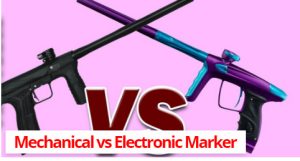You’re thinking about having a paintball marker, but you’re not uncertain whether to choose a mechanical or electric one. Both kinds can fire paintballs, but they work inversely. Understanding their differences and benefits will support you in determining which marker suits you best.
Paintball Gun Basics
All types of paintball markers are intended to shoot paintballs at fast speeds consuming compressed gas such as CO2 or air.

After a paintball marker shoots, a small bolt drives a paintball into the ball barrel and instantaneously closes the paintball in the barrel. Then, a controller discharges compacted gas which inflates in the barrel and forces the ball at the end.
The main variance between different paintball guns lies in their working of the release of the ball into the barrel, and how the barrel closes and gas is discharged into the barrel.
Although there are huge variety of paintball guns and their working ways are also different, we can categorize them into two main types: mechanical and electronic
Basically, mechanically triggered guns are mechanical guns whereas battery and circuit board-driven guns are electric guns. You can find a third type of paintball gun which is a combination of electric and mechanical guns known as electro-mechanical markers.
Mechanical Paintball Guns
Many half-automatic paintball markers work with a blowback mechanism. Here’s how it works: when you tweak the trigger, a bolt is out. This bolt is pressed forward by a coil, and it thrusts the paintball into the container.

When the paintball is inside the barrel, the bolt knocks a pin, which further unlocks a valve, letting air move down the barrel. The air’s force drives the bolt back to its initial position. The word “blowback” is used because the bolt is put back into place by the air.
Types of Mechanical Guns
There are several different kinds of mechanical markers available in the market. Every mechanical gun has a different price range from simple plastic guns to delicate military-style guns. In this article, we will talk about the most simple and eagerly accessible mechanical markers.
The Required Maintenance
Mechanical guns are usually very trustworthy and don’t require much regular upkeep. It’s a worthy idea to clean and grease them after a few practices, or even better if they clean them after each practice.
If the O-rings wear out, you should exchange them as required. These guns are generally stress-free to take apart. If an issue arises, spare parts are reasonably priced, and someone with mechanical skills can regularly renovate them without much struggle.
Compared to electric guns, mechanical guns are generally slower, less accurate, and less reliable. The expanse of air pushing the paintball out of the barrel contrasts from one shot to another shot. It causes minor variations in ball speed which can disturb accuracy, yet only slightly.
Electronic Paintball Guns
Electronic markers, sometimes titled electro-pneumatic markers, shoot paintballs via battery-driven circuit panels. These circuit panels have solenoids that make the gunfire when you pull the trigger. The circuit panel can be automated to make the gun shoot spontaneously, in spurts of three shots, or in other ways.
Electronic guns also use controllers to make sure they shoot reliably. These controllers are like machines that fill in the air at altered pressures from a chamber and then discharge the air at a steady, lower pressure.
Types of Electronic Guns
Electronic markers are available in different varieties with changed interior systems. However, the basic advantages and disadvantages remain the same in all types of electric guns despite the fact they have altered controllers, bolts, and valves that can affect working.
The Required Maintenance
Various types of electronic guns involve particular regular upkeep. It usually involves simple cleaning and applying lubricant, either with grease or oil, according to the gun. It’s important to declaim your guidebook and wisely follow the provided guidelines.
Electronic guns can be more challenging to take parts separately. They generally include comprehensive manuals that clarify how to undo and reconvene every part of the marker. You have to follow these guidelines cautiously during routine upkeep.
Since electronic markers are sophisticated, it’s best to leave any important upkeep or upgrades to an expert.
Electric guns are superior to mechanical ones in numerous ways. They are more trustworthy, accurate, and can shoot quicker.
Electro – Mechanical Guns
Electro-mechanical guns are similar to regular guns, but they have an electronic button that makes the gunfire by pushing a screw. The mode in which they shoot is almost the same as a simple mechanical gun. Though, the electronic circuit panel inside them permits you to shoot in altered ways like constantly, in bursts of three, and further modes.

The Required Maintenance
The required upkeep for electro-mechanical markers is mostly the same as for mechanical markers.
This marker is a combination of two varieties, so it offers you the benefits of both.
Electro-mechanical markers share alike drawbacks with mechanical markers. These drawbacks include:

